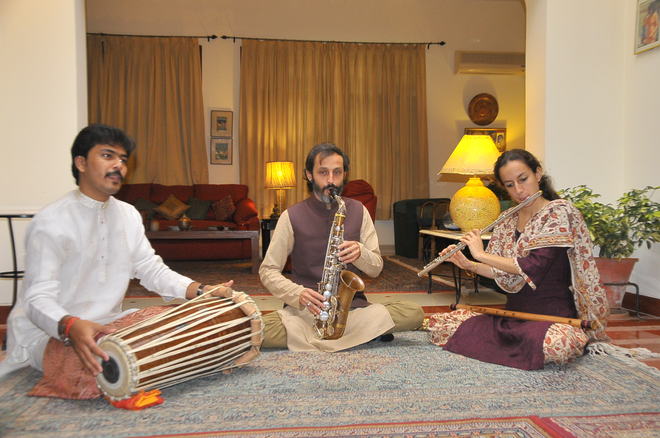A beginning with bansuri...
Manpriya Singh
Was it the bansuri or was it Hariprasad Chaurasia? The live performance by the Indian classical flutist was when the quest for music that could truly express stopped and the journey into Indian classical began.
“We attended his live concert in 2006, were mesmerized and purchased two bansuris on Ebay,” laughs the innovative musical duo Igino Giovanni Brunori and Virginia Nicoli as to how bansuri was the opening door to whatever Indian classical music was yet to throw in their way.
Even though both were trained in western classical music since childhood (Virginia Nicoli with the silver flute and Igino Giovanni Brunori with the saxophone), there was something amiss. “Let’s put it this way. We were a little bored and with Indian classical music we found just the way to express ourselves artistically,” joins in Virginia of the duo in Chandigarh to enthrall the audience with silver flute and saxophone, as a part of 38th Annual Chandigarh Sangeet Sammelan organised by Indian National Theatre. Soon after meeting through music, they began to study with the bansuri. Graduation in bansuri in the Indian Classical Music Conservatorium of Vicenza followed.
India, as they know it
It was only a matter of time when studies with the Gundecha Brothers in the Dhrupad Sansthan of Bhopal began. “Currently we spend half of the year in Italy and the other half in Bhopal, where we have been learning for close to eight years,” shares Igino. “It is in the countryside, it is very clean, silent and we get the time and inspiration for playing.” A strong spiritual connect with music, requires a demanding share of discipline. “Which involves waking up at five in the morning and sadhna for 1 hour.”
West meets East
It’s a day before the performance and they are currently on a few minutes of interrupted break from their practice. “We’ll start with the Raga Yaman and see how it goes.”
Music, that sounds harmonious and positive even to the uninitiated. But how can they play Dhrupad on the western instruments is a recurring question. “On the suggestion of our Gurus, we have started to use western instruments to play Indian music,” adds Virginia. Their performances using, bansuri, silver flute, saxophone and voice, and a table or a pakhawaj, is a unique musical language in which raga is one of the core ingredient.
However, defining music (especially in times of liberally used word fusion) is tougher than it sounds. “It’s less of fusion but more of bringing things and instruments into Indian tradition of music. You can call it contemporary ragas...definition is like compartmentalization. It’s all in the mind.” And minds can be restricting, in matters of heart and pursuits of passion.
manpriya@tribunemail.com
To perform in the auditorium of Bharatiya Vidya Bhawan—27, Chandigarh, on October 31 at 6pm.










